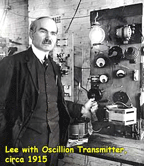October 30, 2004
more on radio's history, #2:

the radio voice
This carries on from the earlier post, more on radio's history, #1.
Marconi’s receivers could pick up morse code – but not the continuous oscillations of the human voice. It was Reginald Fessiden and Lee De Forest who developed the possibilities of continuous wave transmission that would make voice communication possible.
Fessenden, in partnership with Swedish engineer, Ernst F.W. Alexanderson, then working for GE, designed an alternator, a "critical breakthrough in radio technology and elegant evidence of Fessenden's genius in synthesizing his previous work in the electric power industry with his need for a transmitter" (Douglas, Inventing American Broadcasting, 156). By 1906 he had transmitted the human voice over a distance of 10 miles. Fessenden also established an experimental station in Brant Rock, Massachusetts, just south of Plymouth. From there he wrote to phonograph companies asking for a good phonograph and several records, especially recordings of Sousa, Caruso, and violin solos. At 9 p.m., Christmas Eve, 1906, when wireless operators of several United Fruit Company ships in the Atlantic, tipped off to expect something unusual on their NESCO*-provided sets, listened in, they heard Fessenden transmit a recording of Handel’s "Largo" on an Ediphone, play "Oh Holy Night" on the violin, and read from the bible before wishing them a Merry Christmas.
"The Christmas Eve program is still considered the first radio broadcast in American history…" (Douglas, 156).
Lee De Forest, on the other hand, "never shy of borrowing from the work of others" (Douglas), made use of the work of John Ambrose Fleming to produce a device known as "the audion." The prototype of the 3-element vacuum tube, De Forest’s "audion" was able to receive and amplify music and the human voice.
In 1909 De Forest began manufacturing wireless telephone sets for the Navy; and testing each set by means of phonograph records. "Much to my surprise," he wrote later, "many wireless amateurs and professional operators intercepted and enjoyed these test transmissions..." By 1914 he was broadcasting both music and voice from his laboratory north of Manhattan.
In later years, all inventors, Fessenden and de Forest included, would reflect back on their radiophone work as broadcasting. But their major purpose at the time was to make a fortune either by finding a wireless replacement for the wired telephone or by finding an acceptable system the Navy would use for all of their ships.
Between 1912 and 1917, the rights to the continuous wave components these inventors invented were transferred to large corporations like G.E. and AT&T. But while the corporations wrangled over turf and patents, it was "American amateurs [who] unwittingly revealed where the real radio profits lay" (Douglas, 291).
*National Electric Signaling Company, organized in 1902 by Fessenden and his two partners, Thomas Given and Hay Walker, Jr.
Posted by newradio at October 30, 2004 10:15 AM
